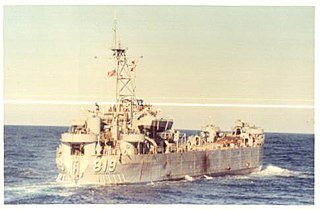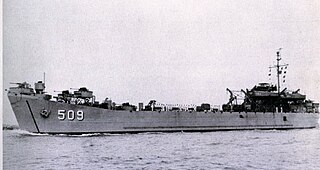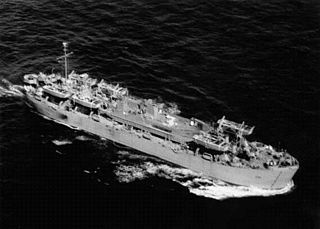
USS Luzerne County (LST-902) was an LST-542-class tank landing ship built for the United States Navy during World War II. Named after Luzerne County, Pennsylvania, she was the only U.S. Naval vessel to bear the name.

USS Tuscaloosa (LST-1187) was the ninth of the Newport-class tank landing ships of the United States Navy, which replaced the traditional bow door-design tank landing ships (LSTs). The vessel was constructed by the National Steel and Shipbuilding Company in San Diego, California and was launched in 1969 and commissioned in 1970 and the second ship of the United States Navy to be named after the city of Tuscaloosa, Alabama. The LST participated in the Vietnam War and was decommissioned in 1994. The ship was laid up until being sunk as a target ship during a sinking exercise in 2014.

USS Hampshire County (LST-819) was an LST-542-class tank landing ship built for the United States Navy during World War II. Named for counties in Massachusetts and West Virginia, she was the only U.S. Naval vessel to bear the name.

USS Bulloch County (LST-509) was an LST-491-class tank landing ship built for the United States Navy during World War II. Named for Bulloch County, Georgia, she was the only U.S. Naval vessel to bear the name.

USS Satyr (ARL-23) was one of 39 Achelous-class landing craft repair ships built for the United States Navy during World War II. Named for the Satyr, she was the only US Naval vessel to bear the name.

Operation Game Warden was a joint operation conducted by the United States Navy and South Vietnamese Navy in order to deny Viet Cong access to resources in the Mekong River Delta. Game Warden and its counterpart Operation Market Time are considered to be two of the most successful U.S. Naval actions during the Vietnam War.

USS Coconino County (LST-603), originally USS LST-603, was a United States Navy LST-542-class tank landing ship built for the United States Navy during World War II and in commission from 1944 to 1955 and from 1966 to 1969. Named after Coconino County, Arizona, she was the only U.S. Navy vessel to bear the name.

USS Jerome County (LST-848) was an LST-542-class tank landing ship built for the United States Navy during World War II. Named after Jerome County, Idaho, she was the only U.S. Naval vessel to bear the name.

USS Garrett County (LST-786) was an LST-542-class tank landing ship built for the United States Navy during World War II. Named after Garrett County, Maryland, she was the only U.S. Naval vessel to bear the name.

USS LST-821, renamed USS Harnett County (LST-821/AGP-281), was an LST-542-class tank landing ship built for the United States Navy during World War II. She was named for Harnett County, North Carolina and was the only U.S. Naval vessel to bear the name. She served the United States Navy in World War II and the Vietnam War. She was transferred to South Vietnam's Republic of Vietnam Navy, which named her RVNS My Tho (HQ-800).

USS Pitkin County (LST-1082) was an LST-542-class tank landing ship built for the United States Navy during World War II. Named after Pitkin County, Colorado, she was the only U.S. Naval Vessel to bear the name.

USS Terrell County (LST-1157), originally USS LST-1157, was a Terrebonne Parish-class tank landing ship built for the United States Navy in 1952. Named for Terrell County, Texas, and Terrell County, Georgia, she was the only U.S. Navy vessel to bear the name. She was later lent to Greece and subsequently sold to Greece, being renamed Oinoussai (L104) in Greek service.

USS Henry County (LST-824) was an LST-542-class tank landing ship built for the United States Navy during World War II. Named for counties in Alabama, Georgia, Illinois, Indiana, Iowa, Kentucky, Ohio, Tennessee, and Virginia.

USS Hickman County (LST-825) was an LST-542-class tank landing ship built for the United States Navy during World War II. Named after counties in Kentucky and Tennessee, she was the only U.S. Naval vessel to bear the name.

USS Iredell County (LST-839) was an LST-542-class tank landing ship built for the United States Navy during World War II. Named after Iredell County, North Carolina, she was the only U.S. Naval vessel to bear the name.

USS Jennings County (LST-846) was an LST-542-class tank landing ship built for the United States Navy during World War II. Named after Jennings County, Indiana, she was the only U.S. Naval vessel to bear the name.

USS Kemper County (LST-854) was an LST-542-class tank landing ship built for the United States Navy during World War II. Named after Kemper County, Mississippi, she was the only U.S. Naval vessel to bear the name.

USS Madera County (LST-905) was a LST-542-class tank landing ship built for the United States Navy during World War II. Named after Madera County, California, she was the only U.S. Naval vessel to bear the name.

USS Monmouth County (LST-1032) was an LST-542-class tank landing ship built for the United States Navy during World War II. Named after Monmouth County, New Jersey, she was the only U.S. Naval vessel to bear the name.

USS Vernon County (LST-1161) was a United States Navy, Terrebonne Parish-class tank landing ship in commission from 1953 to 1973. She saw extensive service in the Vietnam War before being transferred to the Venezuelan Navy, where she became Amazonas (T-21).






















